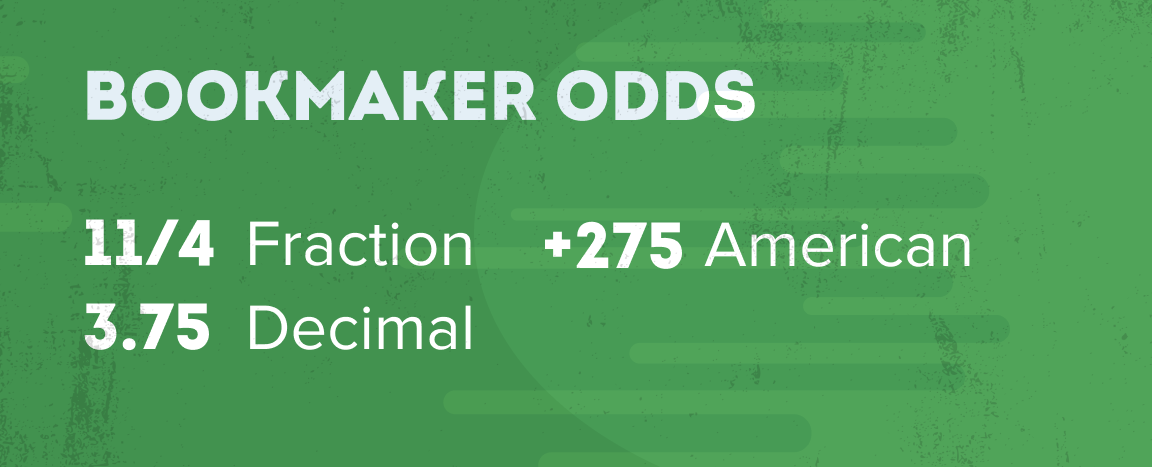
The primary service of bookmakers is to provide betting options on possible outcomes of an event. The amount of money that a punter stands to win is determined by what is known as odds. Odds are essentially arrived at by studying the probabilities of the possible outcomes of a given event. Odds also establish the house's edge. There are three main types of betting odds, fractional, decimal, and American odds. The different types can be viewed as just different formats of representing probabilities, as one format can be converted to any of the other forms. This article will explain everything regarding the different types of odds and how they should influence your betting decisions.
What Are Decimal Odds?
Decimal odds are the most commonly used by a majority of the popular bookmakers across the world. One of the main reasons for the popularity of decimal odds is that they are quite easy to understand and calculate. They ideally indicate the amount of money that a bettor stands to gain for each unit of a bet. To ensure that the accuracy of the odds is high, the bookmakers usually give the odds to two decimal places or more. It is important to note that the decimal odds factor in the returned stake as well.
For example, the odds of a particular outcome can be set to 3.00. That means that if the bettor makes the correct prediction, the returns will be three times the amount of money wagered. The potential total return is calculated by multiplying the stake amount by the decimal odds. For a wager of $10, the total returns will be $10 x 3.00, which equates to $ 30. The profits will thus be $20 as $10 counts as the stake unit.
What Are Fractional Odds?
Fractional odds are the next popular type of odds, commonly used in the UK. The concept behind the fractional odds is similar to decimal odds, as they are both based on a single unit of stake. However, the fractions do express a different meaning. The fraction odds indicate the amount of profit that a one-unit stake will return, while decimal odds indicate the total amount of return from one stake unit.
For example, a bookmaker may place the fractional odds for a particular event as 2/1. That means that for the correct outcome, the punter will get two times the amount of unit stake. For an odd of 5/1 and a unit stake of $10, the punter would win $50 as profit. The calculation for the potential total return is done by multiplying the stake by the odd fraction and then adding it to the stake amount.
What Are American Odds?
The American odds, which are also referred to as money lines, are the third type of odds commonly used. They are a bit different from decimal and fractional odds, as they are based on a 100-unit stake. They indicate both negative and positive outcomes based on how they are written. When written positively, the odds show the amount of profit that can be made on a 100 stake. When written negatively, the odds indicate the amount of stake needed to make 100 on a bet.
For example, a bookmaker may place odds for team A as +582 and odds for team B winning as -760. That means that a punter has to stake $100 to win 585 dollars when predicting a win for team A. The total payout will thus be 585 dollars plus the $100 stake. To bet on team B, a punter has to stake $760 to win $100 potentially.
How Bookmakers Make Their Odds
To become a serious bettor, you should understand everything that there is to know about betting odds. That includes how bookmakers come up with the odds in the first place. Bookmakers start by determining the true odds. True odds are determined by considering various factors that may influence the result, such as historical precedents, statistics, prior form, and expert analysis, among many others. The true odds are supposed to be as accurate as possible concerning outcome prediction.
After determining the true odds, the bookmakers then adjust them downwards and then offer them to punters. The adjustment is meant to give the bookmaker a margin. The margin helps to reduce the bookmakers' liability, which can lead to losses in case punters do not bet according to the bookmakers' predictions.
Using Odds to Determine the Value of a Betting Opportunity
To determine if a betting opportunity is valuable, you should assess your probability of an outcome against the implied probability given by the bookmaker in terms of odds. If your estimated odds are higher, the betting opportunity can be considered valuable. Keep in mind that the bookmakers always include their profit margins in the odds. They have to make a profit irrespective of the outcome of the event.
Add comment
Comments (0)